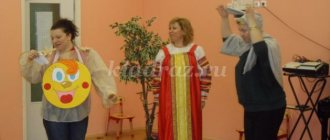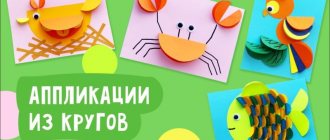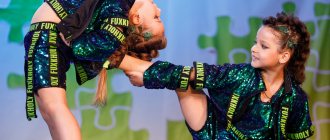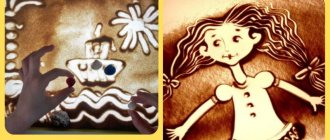Progress of the game.
The object is placed on a chair in the center of the circle or passed around the circle from one child to another. Everyone must act with the object in their own way, justifying its new purpose, so that the essence of the transformation is clear. Options for the transformation of different objects:
a) pencil or stick - key, screwdriver, fork, spoon, syringe, thermometer, toothbrush, paint brush, pipe, comb, etc.;
b) a small ball - an apple, a shell, a snowball, a potato , a stone, a hedgehog, a bun, a chicken, etc.;
c) notebook - mirror, flashlight, soap, chocolate, shoe brush, game.
You can transform a chair or a wooden cube, then children must justify the conventional name of the object.
For example, a large wooden cube can be turned into a royal throne, flowerbed, monument, bonfire, etc.
Card No. 11 “KING (version of the folk game)
»
Target. Develop actions with imaginary objects, the ability to act in concert.
Project in the second early age group. Theatrical activities in kindergarten
Project for preschoolers 2-3 years old “We play theater”
Type of project: educational - creative. Implementation period: short-term project (1 month). Project participants: children, teachers, parents. Age of project participants: first junior group. Explanatory note Theatrical activities are one of the most effective ways to influence children, in which the principle of learning is most fully and clearly manifested: learn by playing. Theatrical games are the most important factor stimulating the development of coherent speech in children. They stimulate active speech by expanding vocabulary and improving the articulatory apparatus. The child learns the richness of his native language and its means of expression. Speech is not only a means of communication, but also a tool of thinking, creativity, a carrier of memory, information, etc. Expressiveness of speech develops throughout preschool age: from involuntary emotional - in children, to intonation speech - in children of the middle group and to linguistic expressiveness speech - in children of older preschool age. For the development of speech, it is necessary to create conditions in which each child could express his emotions, feelings, desires and views without being embarrassed by the presence of outside listeners. It is important to teach this in early childhood. Theatrical games can be of great help with this. They always make children happy and enjoy their constant love. By participating in theatrical activities, children get acquainted with the world around them in all its diversity through images, colors, sounds, and skillfully posed questions force them to think, analyze, draw conclusions and generalizations. Improvement of speech is also closely related to mental development. Theatrical activities allow the child to solve many problematic situations indirectly on behalf of a character. Relevance of the project: A fairy tale teaches you to understand goodness, to reason about people’s actions, If you are bad, then condemn him, And if you are weak, then protect him! Children learn to think, dream, “Who?”, “Which?”, “Why?” answer, imitate the heroes of fairy tales, increase knowledge about the theater, develop your speech. Modern children live in a powerful flow of information, live communication is replacing computers and television, and this trend is constantly growing, so speech development is becoming an increasingly pressing problem in our society. Thus, theatrical games help the child’s speech development. Project goal: Development of monologue and dialogic speech skills through theatrical activities. Resource support: • tabletop theaters: “Ryaba Hen” • bibabo theater: “Three Bears” • finger theater: “Teremok” • costumes for the fairy tale “Turnip”, “Kolobokok”, “Cat’s House” • plot pictures • didactic games: “ Who? Which? What is he doing?”, “Who eats what?”, “Sequences”, “Changes of moods”, “Actions”, “Tell a fairy tale using pictures”, puzzles “Favorite fairy tale characters”, coloring books based on the fairy tales “Teremok”, “Kolobok”, "Turnip". • attributes for the outdoor games “Hen and Chicken”, “Goat-Dereza”, “Cucumber-Cucumber”, “Bear-toed Bear” Project objectives: 1. Give students basic ideas about the theater (about how to behave in the theater, about puppets who take part in the performance, about various types of theater). 2. Continue to expand children’s understanding of the fairy tales based on which the theater shows. 3. Introduce the features of the theater display. 4. Develop facial expression and fine motor skills of the fingers. 5. Develop the ability to identify oneself with a theatrical character; 6. To increase the competence of parents regarding the development of speech in children and the development of creative abilities through theatrical activities. 7. Enrich the subject-development environment. The main requirements for organizing theatrical activities at an early age are: - variety and content of topics appropriate for a given age; - constant, daily inclusion of theatrical games in the child’s life, i.e. in all forms of organization of the pedagogical process; - developing interest in theatrical games, constantly expanding the gaming experience, encouraging and developing children’s desire for theatrical and gaming activities; - interaction between children and adults. Form of work with children and parents: - Individual; - Group. Implementation plan: I Organizational and preparatory stage (2 weeks) Educational areas.
Activity. Forms and methods of work. "Social and communicative development." 1) Game activity:
1. Role-playing games: “Going to the theater”, “Katya the doll recites her favorite poems”. Goal: To develop children’s knowledge about the rules of behavior in the theater. Develop the ability to be polite and attentive to each other. Learn to recite familiar poems loudly and clearly.
Role-playing games: “In the toy store”, “Bookstore”.
Goal: Teach children to answer questions. Clarify and enrich children's ideas about various books with fairy tales and toys. Learn to look at objects. Develop speech. 2) Value-based attitude towards work: 1. Assignments: “Washing toys”, “Washing doll clothes”. Goal: To develop skills together with an adult and under the supervision of adults to properly care for toys and put them in order 2. Observation of an adult’s work: “Ironing doll clothes” Goal: To attract children’s attention to what and how an adult does, why he does what or other action. Encourage a desire to help adults. 3) Basics of safe behavior: 1. Conversations with children “When we went to the theater.” Goal: Continue to familiarize children with the rules of road safety. 2. Didactic exercises “You can - you can’t”, “Show me how to do it correctly.” Goal: To develop the ability to comply with safety rules in public places. "Cognitive Development". D/I “Sequences” Goal: to develop the ability to recreate a sequence of events from familiar fairy tales, lay out illustrations sequentially, naming what happens in them; develop speech and logical thinking. D/I “Change of Moods” Purpose: To develop an idea of the main emotions and ways of expressing them, to learn to name the main emotions, to show them. D/I “Actions” (crawls, lies, jumps, hangs, swims) Goal: Expand subject and verbal vocabulary; develop the ability to select suitable objects for actions; develop phrasal speech, thinking, attention.
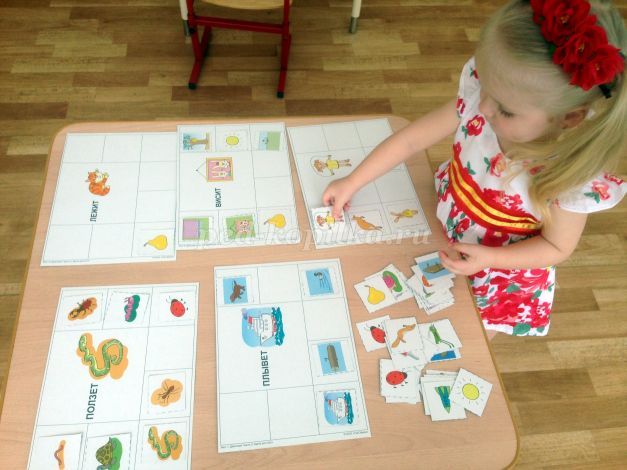
Looking at illustrations for your favorite fairy tales, collections of poems, nursery rhymes, etc. Goal: To teach to carefully examine illustrations, find familiar characters, name them, follow the development of the plot; learn to answer the questions “Who?”, “Which?”, “What is he doing?”, learn to compare the text and pictures to it. Enrich your vocabulary. Looking at an album with photographs “Me and My Mommy”, photographs from the past matinee “Mom’s Holiday”, “Life in Kindergarten” Purpose: invite children to tell who is shown in the photographs, teach them to say their name, surname, and mother’s name. Develop speech.
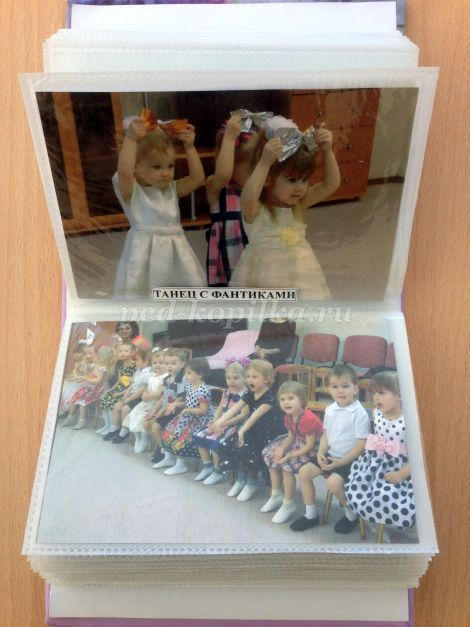
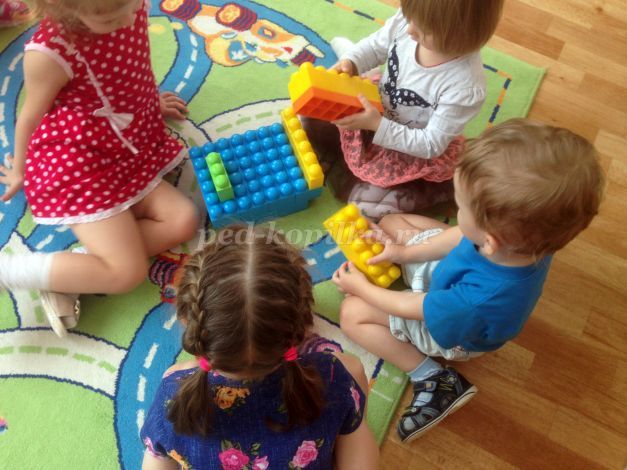
2. Modeling - a bun, a mouse, grains for a chicken (fairy tales “Kolobok”, “Teremok”, “Ryaba Hen” “Dereza Goat”).
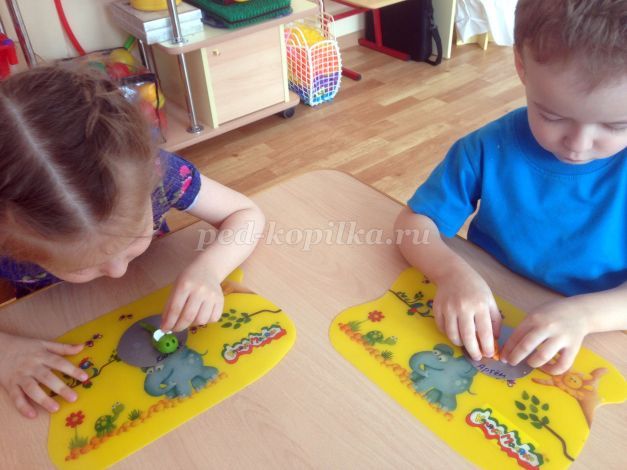
3. Finger painting – grains for a cockerel (fairy tale “Zayushkina’s hut”).
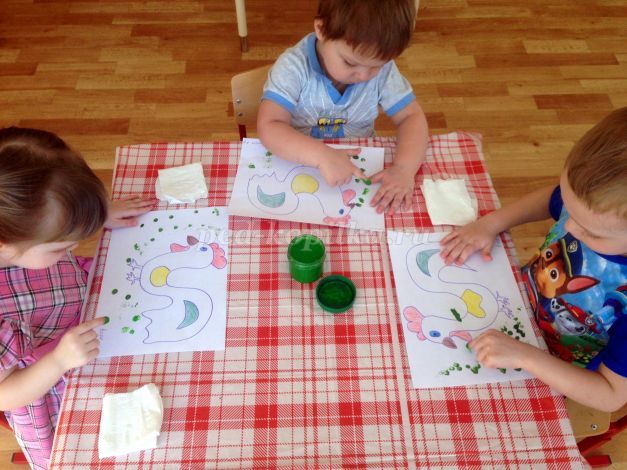
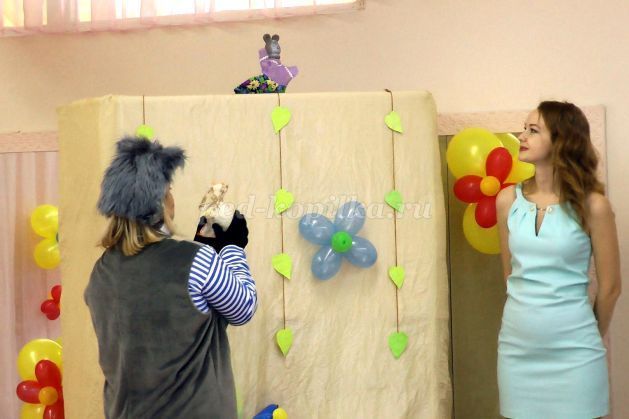
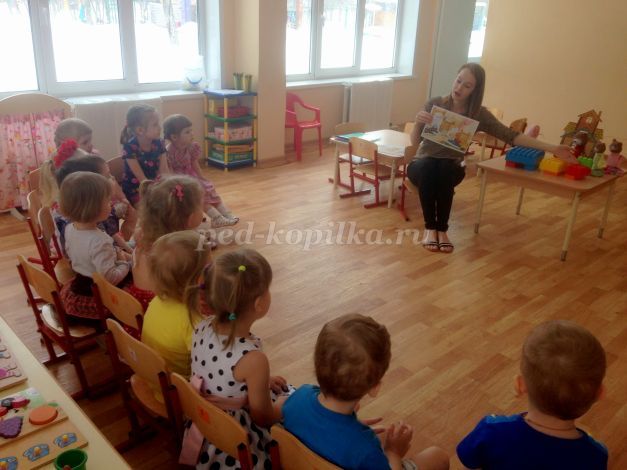
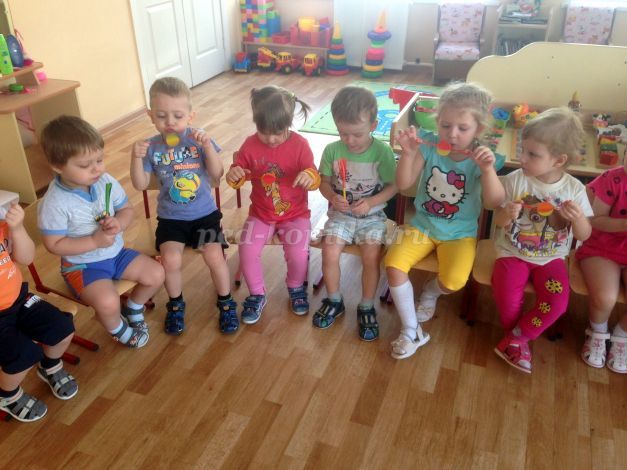
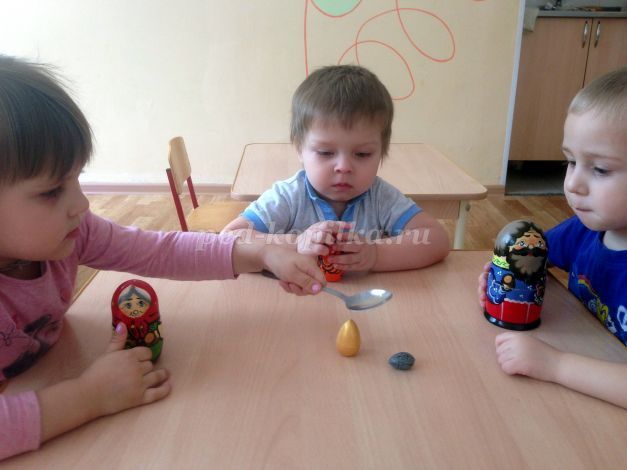
— Stock dolls, fairy tale “Teremok.” These dolls are driven using one or two rods (sticks). They are very useful for the development of fine motor skills, which contributes to the development of speech in children. These dolls also develop flexibility in the fingers, hand and wrist.
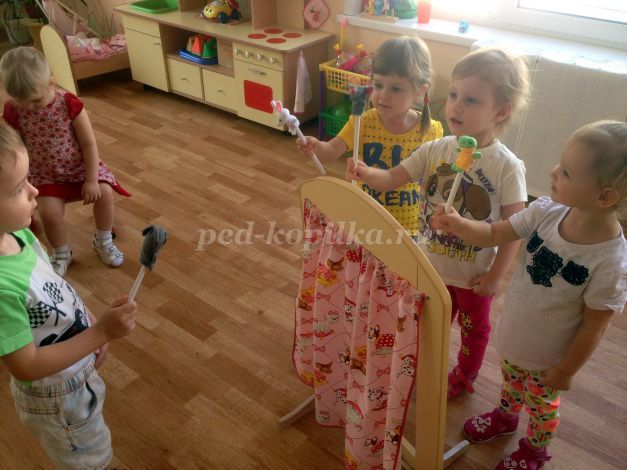
— Bibabo Theater based on the fairy tale “The Three Bears”. Children love to play with Bibabo dolls. However, they are still difficult to manage.
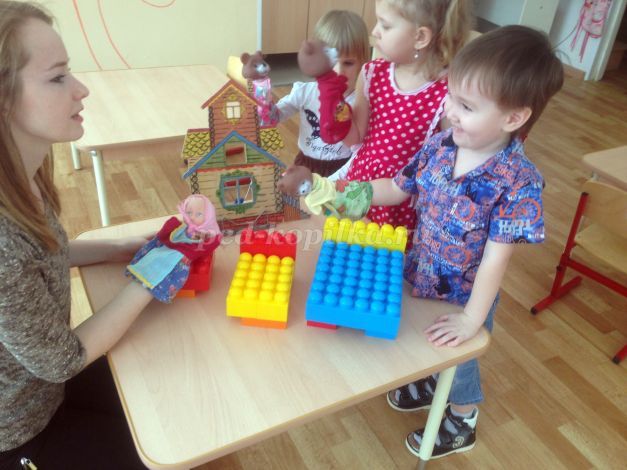
— Finger Theatre, fairy tale “Teremok”. This is an excellent speech and sensory-motor simulator. Dolls develop finger mobility, help master the speech of characters, help develop vocabulary and activate speech functions.
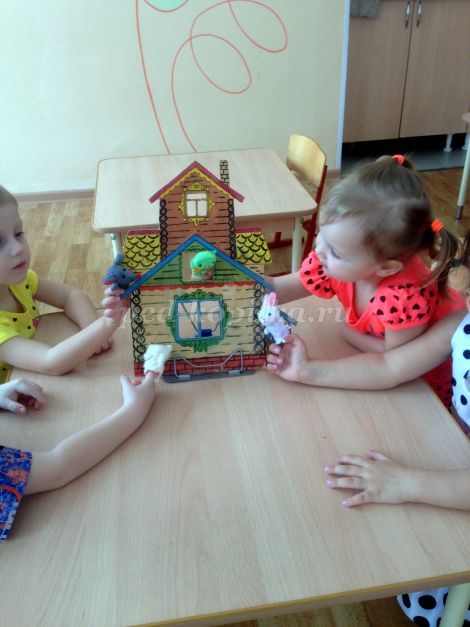
— Dramatization with masks of the fairy tales “Cat’s House”, “Kolobok”, “Turnip”. Helps children convey the image of the character.
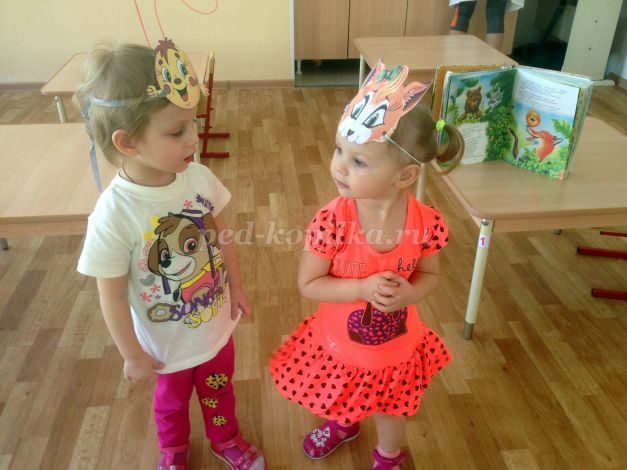
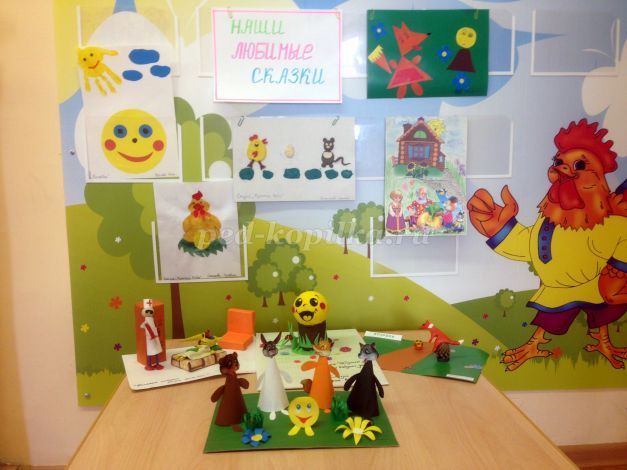
We recommend watching:
Master Class. DIY shadow theater
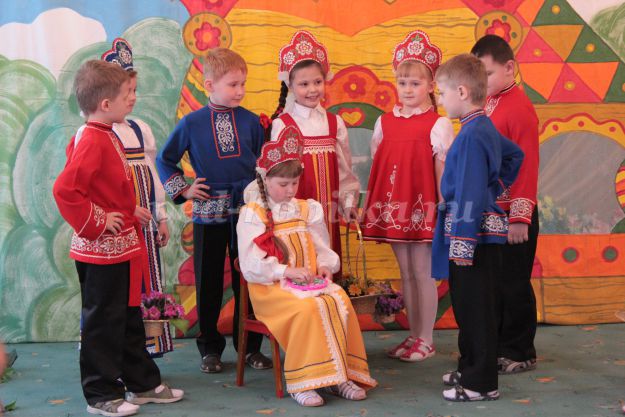
Photo report from the fairy tale “The Scarlet Flower” Synopsis of a theatrical lesson in the second junior group Synopsis of a joint theatrical activity in a preparatory group on Russian folk tales
Similar articles:
The fairy tale “At the behest of the pike” in a new way. Role-based script for older preschoolers
Card index of theatrical games in the younger group
Card index
in the younger group
Explanatory note
Theatrical play is an effective means of social-personal, cognitive-speech and artistic-aesthetic development of a preschooler. The development of theatrical play in preschoolers is more effective with a special organization of the pedagogical process.
This becomes possible if the teacher gradually reorients the child from the process of the game to its result. The path to development of play is joint play between an adult and a child, the creation of an enriched play environment that encourages independent play creativity in free interaction with toys and peers. Play as part of the educational field “Socialization” is integrated with all educational fields, since it is the main form of implementation of various types of children's activities, including organized educational activities, a method of educating and developing younger preschoolers, and a form of organizing the lives of children in kindergarten.
«The turnip grew big and big"
Russian folktale
Tasks:
Read a fairy tale to the children.
To teach listening to a story using a visual image Staged fairy tales on flannelgraph
Game-situation “In our yard” To evoke positive emotions in children;
Enrich the experience; awaken interest in the game, the desire to imitate the intonation of an adult’s voice.
The BI-BA-BO puppet theater and flannelgraph are used
A.
Barto “Toys”
Tasks:
Introduce poems.
Teach children to perform characteristic actions when reading again, repeating lines of text after the teacher
To develop the ability to convey basic emotions through facial expressions, gestures, and movements.
Encourage children's willingness to participate.
Used tabletop theater toys
Fairy tale "Kolobok"
»
Tasks:
Arouse interest in theatrical play through the first experience of communicating with characters.
Invite children to follow the development of the plot based on illustrations,
Develop attention and visual - effective thinking;
Learn to name characters and their actions. Reinforce in speech the names of animals and their characteristics; expand the active vocabulary: round, ruddy, red and cunning, clubfoot, etc.
Theatrical game based on a fairy tale (the theater on spoons, Bi-Ba-Bo is used;)
Nursery rhyme “Cucumber, cucumber...”
Cucumber, cucumber,
Don't go to that end
There's a mouse living there
He'll bite your tail off!
Tasks:
Teach children to pronounce a nursery rhyme. Mastering affectionate behavior (cucumber, ponytail, mouse).
Develop attention, enrich vocabulary.
Cultivate careful behavior.
Option 2. Use in a game (the mouse lives there - the children run away
Theatrical nursery rhyme game (head masks are used)
Folk game: “The gray bunny is sitting”
Tasks:
Improve the ability to examine objects, learn to examine, feel;
Learn to perform movements as shown by the teacher and pronounce the words of the song
Develop emotional responsiveness, the desire to communicate with peers, play together;
Game - the situation “The girl forgot to feed the kitten, he couldn’t remember how to ask for food.”
Tasks:
Learn to identify yourself with a theatrical character; develop mindfulness;
Learn to combine movements and speech; consolidate knowledge about the environment.
The game is the situation “For the grandfather, for the woman, the Ryaba Hen laid a golden egg.”
Tasks
Stimulate children's emotional perception of theatrical play and active participation in it;
Develop children's physical activity. Retelling a fairy tale with movements.
Strengthen the ability to imitate movements
Theatrical play based on a fairy tale, all types of theater are used
“ We won’t tell you where we were, but we’ll show you what we did.”
Tasks:
Encourage children's attempts to participate in a collective conversation and make joint decisions; develop creative imagination; encourage children to improvise.
Using a counting rhyme, the driver is selected. He leaves the room. Children agree on what and how they will portray. The driver returns and asks: “Where have you been, boys and girls? What did you do?" The children answer: “We won’t tell you where we were, but we’ll show you what we did.”
Children show the actions they came up with.
During the game, the teacher first advises what and how to depict. When the children get used to it, he only suggests what to depict, and how to do it, they decide for themselves
TV oral tasks for the development of pantomime.
Tasks.
1. Show how the Goat (Baba Yaga, Little Red Riding Hood, etc.):
- looks in the mirror;
- tries his favorite dish
- tries his least favorite dish
- Dialogues - pantomimes:
- conversation between two “foreigners” who do not know each other’s language, using gestures in various situations, for example: in a store, at a train station in a pharmacy, etc.;
- act out a situation in which one fairy-tale character steps on another’s foot (for example, on a tram); show how they sort things out using gestures.
3. Riddles - pantomimes:
- in a store (toy store, grocery store, grocery store, furniture store, etc.): guess what product the buyer needs or what product is on the shelf;
- at the zoo: guess who is sitting in the cage;
- guess the profession (based on characteristic movements and posture);
- guess how the journey took place (by boat, plane, train, etc.);
- guess what the weather is like outside;
- identify a passerby by their gait (ballerina, soldier, very old person, fashion model, person whose shoes are pinching, etc.).
4.Show (with hands or fingers):
- Stay where you are!
- Come with me!
- Goodbye!
- Let's make it up.
- I love you!
- I'm afraid.
Fairy tale "Kids and the Wolf"
Tasks:
Introduce children to the work, teach them to follow the development of the plot based on illustrations. During special moments
Game "Bunnies for a walk"
Tasks:
Teach children to perform playful actions and engage in play with peers.
To develop the ability to perform basic role-playing actions. Game situation using various attributes (table theater, circle theater, etc.)
Tasks (children hold “bi-ba-bo” dolls or ordinary toys in their hands
).
1. The dolls meet each other and:
a) say hello
b) ask each other about health,
c) say goodbye.
2. One doll accidentally pushed the other. We must ask for forgiveness and, accordingly, apologize.
3. The doll is celebrating her birthday. Her friends come to her and:
a) congratulate you on your birthday and give gifts.
b) the doll thanks for the congratulations and invites you to the table.
c) one of the guests was late: ask for forgiveness for being late.
d) one of the guests accidentally spilled compote on the tablecloth, play out the actions of the hosts and the offender.
3. Some tasks can be offered to children to complete without dolls:
a) knock, go into the group and call one of the children with a gesture (silently, so as not to interrupt the teacher’s story);
b) go to the head (methodologist, speech therapist, etc.) and give her a message;
c) explain to “mom” why clothes are dirty after visiting kindergarten;
d) apologize to the children for the fact that the ball rolled and broke the sand buildings.
Note: the content of communication sketches can include exercises on etiquette and culture of behavior.
Progress of the game.
Children are asked to come up with and show several options for behavior for a specific task: a person “goes”
,
“sits”
,
“runs”
,
“raises his hand”
,
“listens”
, etc.
Each child comes up with his own behavior, and the other children must guess what he is doing and where he is. The same action looks different under different conditions.
Children are divided into 2-3 creative groups , and each receives a specific task.
I “sit” task
.Possible options:
a) sit in front of the TV;
b) sit in the circus;
c) sit in the dentist’s office;
d) sit at the chessboard;
e) sit with a fishing rod on the river bank, etc.
II “go” task
.Possible options:
a) walk along the road, surrounded by puddles and mud;
b) walk on hot sand;
c) walk along the deck of the ship;
d) walk along a log or a narrow bridge;
e) walk along a narrow mountain path, etc.
III “run” task
.Possible options:
a) run away, being late for the theater ;
b) run away from an angry dog;
c) run when caught in the rain;
d) run, playing blind man's buff, etc.
IV - task “waving your arms”
.Possible options:
a) drive away mosquitoes;
b) give a signal to the ship to be noticed;
c) dry wet hands, etc.
V - task “Catch the little animal”
.Possible options:
a) cat;
b) parrot;
c) grasshopper, etc.
Card No. 10 “TRANSFORMATION OF AN OBJECT”
Target. Develop a sense of faith and truth, courage, intelligence, imagination and fantasy.
